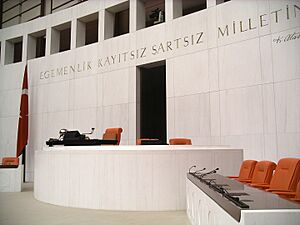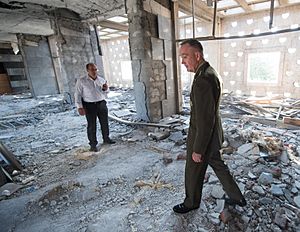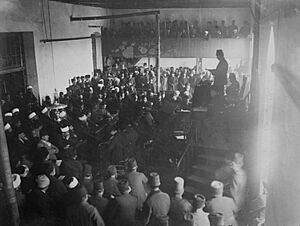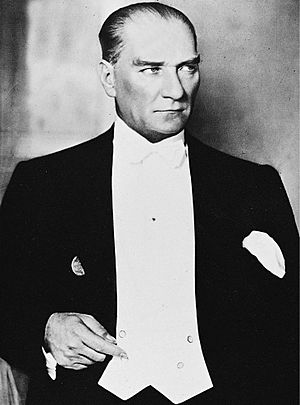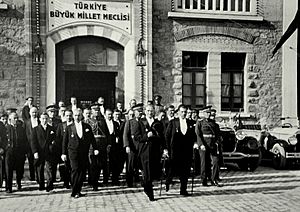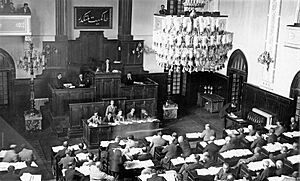Grand National Assembly of Turkey facts for kids
Quick facts for kids Grand National Assembly of TurkeyTürkiye Büyük Millet Meclisi |
|
|---|---|
| 28th Parliament of Turkey | |
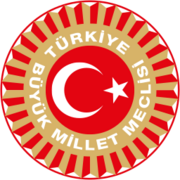
Seal of the Turkish Parliament
|
|
| Type | |
| Type | |
| History | |
| Founded | 23 April 1920 |
| Preceded by | 23 December 1876 as General Assembly |
| Leadership | |
|
Numan Kurtulmuş, AK Party
Since 7 June 2023 |
|
|
Deputy Speakers
|
|
|
Government Group Leader
|
Abdullah Güler, AK Party
Since 3 June 2023 |
|
Main Opposition Group Leader
|
Özgür Özel, CHP
Since 3 June 2023 |
| Structure | |
| Seats | 600 1 non-voting member |
 |
|
|
Political groups
|
Government (272)
Supported by (52)
Opposition (257)
Independent (12)
Vacant (8)
|
| Committees | 19 committees |
|
Length of term
|
5 years |
| Authority | Constitution of Turkey |
| Salary | ₺196,775 monthly |
| Elections | |
| Closed list proportional representation (D'Hondt method with a 7% electoral threshold) |
|
|
Last election
|
14 May 2023 |
|
Next election
|
On or before 7 May 2028 |
| Redistricting | Supreme Election Council |
| Motto | |
| Egemenlik kayıtsız şartsız Milletindir Sovereignty unconditionally belongs to the Nation |
|
| Meeting place | |
 |
|
| General Assembly Hall Grand National Assembly of Turkey 06543, Bakanlıklar Ankara, Turkey |
|
| Constitution | |
| Constitution of Turkey | |
The Grand National Assembly of Turkey (Turkish: Türkiye Büyük Millet Meclisi), often called the GNAT or TBMM, is like the main meeting place where important decisions for Turkey are made. It's the country's single-chamber parliament, where elected representatives, called deputies, work together to create laws. The Turkish Constitution gives it the power to make these laws.
The TBMM was started in Ankara on April 23, 1920. This was during a very important time for Turkey, known as the National Campaign. The parliament was key in helping Mareşal Mustafa Kemal Atatürk, who became the first President of the Republic of Turkey, and his team to build a new government. This new government was formed from the parts of the old Ottoman Empire.
Contents
How the Parliament is Organized
There are 600 members in the parliament, also called deputies. They are chosen for a five-year term through elections. People vote for political parties, and seats in the parliament are given out based on how many votes each party gets. This system is called proportional representation.
To make sure that only parties with enough support get seats, a party needs to win at least 7% of the total votes across the country. This is called an electoral threshold. It helps prevent too many small parties from making it hard to form a stable government. People who don't belong to a party can also run as independent candidates and be elected if they get enough votes.
Speaker of the Parliament
The Speaker is like the leader of the parliament. They make sure meetings run smoothly and everyone follows the rules. After the general election in 2023, Numan Kurtulmuş was elected as the Speaker on June 7, 2023.
Languages Used
The official records of the parliament are translated into four languages: Arabic, Russian, English, and French. While some phrases in Kurdish are allowed, full speeches in Kurdish are not permitted.
Members Over Time
Here are the lists of members elected in recent years:
- Members elected in 1999 (21st Parliament)
- Members elected in 2002 (22nd Parliament)
- Members elected in 2007 (23rd Parliament)
- Members elected in 2011 (24th Parliament)
- Members elected in June 2015 (25th Parliament)
- Members elected in November 2015 (26th Parliament)
- Members elected in 2018 (27th Parliament)
- Members elected in 2023 (28th Parliament)
Groups in Parliament
Political parties that have at least 20 deputies can form a parliamentary group. These groups help organize discussions and voting. Currently, there are several parliamentary groups in the GNAT, including the AK Party, which has the most seats, the CHP, the MHP, the İYİ Party, the DEM Party, and New Path.
Parliament's Working Groups
The parliament has different working groups, called committees, that focus on specific topics. They study issues in detail and prepare reports.
Types of Committees
- Justice Committee: Deals with laws related to justice and courts.
- Constitution Committee: Works on changes and rules for the country's main law, the Constitution.
- Environment Committee: Focuses on protecting nature and dealing with environmental issues.
- Foreign Affairs Committee: Handles Turkey's relationships with other countries.
- Digital Media Committee: Looks at topics related to the internet and digital communication.
- Internal Affairs Committee: Deals with matters inside the country, like public safety.
- Committee for the Inspection of Human Rights: Checks if people's rights are being respected. It has smaller groups, like the Children's Rights Subcommittee.
- Committee for Equal Opportunities for Women and Men: Works to ensure fairness for everyone, regardless of gender.
- National Education, Culture, Youth, and Sports Committee: Focuses on schools, arts, young people, and sports.
- National Defense Committee: Deals with the country's military and security.
- Planning and Budgeting Committee: Plans how the government will spend money.
- Health, Family, Employment, and Social Affairs Committee: Covers health, families, jobs, and social support.
- Agriculture, Forestry, and Rural Works Committee: Focuses on farming, forests, and rural areas.
Research and Investigation Committees
Sometimes, the parliament forms special committees to research a specific topic or to investigate if a high-ranking official, like the President or a minister, has done something wrong. These committees help the parliament keep an eye on how the government is working.
Committee meetings are usually open to members of parliament and government representatives. They can talk in these meetings, but only committee members can propose changes or vote. Reports from these committees are available for all members of parliament to read.
The Parliament Building
The place where the Grand National Assembly meets today is the third building used for this purpose. The very first parliament building was once the headquarters of a political group in Ankara. It was used until 1924 and is now a museum called the Museum of the War of Independence.
The second building, designed by architect Vedat (Tek) Bey, was used from 1924 to 1960. It is now known as the Museum of the Republic.
The current parliament building is a large and modern structure in Ankara. It was designed by architect Clemens Holzmeister. This building was shown on the back of Turkish 50,000 lira banknotes from 1989 to 1999. In 2016, the building was damaged during an event and later repaired.
A Look at History
Turkey has a long history of parliamentary government, even before the current national parliament was created.
Early Parliaments in the Ottoman Empire
Before the Republic of Turkey, the Ottoman Empire also had periods where a parliament helped govern. This was an effort to limit the power of the absolute ruler, the Sultan.
The first time a parliament was set up in the Ottoman Empire was for a short period. Later, a second period of parliamentary rule began in 1908. During this time, many modern rights were introduced, like freedom of the press and the right to form political parties. The government became responsible to the parliament, not just to the Sultan.
The Ottoman parliament was called the General Assembly of the Ottoman Empire. It had two parts: an upper house (Senate) whose members were chosen by the Sultan, and a lower house (Chamber of Deputies) whose members were elected by the public.
Starting the National Assembly
After World War I, the Ottoman Empire faced challenges, and there were plans to divide it. Many Turkish people wanted to create an independent country. This led to the Turkish National Movement.
During the Turkish War of Independence, Mustafa Kemal believed that the Turkish people could only be free by creating their own independent state. The old system of the Sultanate was ended by the new parliament in 1922. This paved the way for the official declaration of the Republic of Turkey in 1923.
Moving to Ankara
On March 19, 1920, Mustafa Kemal announced that a special assembly with great powers would meet in Ankara. He explained how members would be elected. Members of the old Ottoman Chamber of Deputies could also join this new assembly.
This new assembly, called the Grand National Assembly, held its first meeting on April 23, 1920. From this date until the end of the Turkish War of Independence in 1923, this assembly served as the temporary government of Turkey.
The Republican Era
Early Years (1923–1945)
In the early years of the Republic, there were attempts to have more than one political party. The first try was in 1924, but the party was closed after a few months. Another attempt in 1930 also faced difficulties. For a while, Turkey was mainly governed by one party until 1945.
Multi-Party Politics Begins (1945–1960)
Multi-party politics started again in Turkey in 1945 with new parties forming. The Democrat Party was created the next year and won the elections in 1950. Its leaders, Celal Bayar and Adnan Menderes, became President and Prime Minister.
Changes in Government (1960–1980)
In 1960, there was a change in government where the military took control. The parliament was closed, and a new group called the Committee of National Unity took over. They worked on a new constitution, which was approved by the people in 1961.
The 1961 Constitution created a system with two parliamentary chambers and a Constitutional Court. It also focused on protecting people's rights and freedoms. This constitution was changed several times but stayed in effect until another change in government in 1980.
More Changes (1980–2018)
In 1980, there was another change in government. The constitution was put on hold, and political parties were dissolved. A new constitution was written and approved by the people in 1982.
The 1982 Constitution created a single-chamber parliament with 550 members. It also set a 10% electoral threshold for parties to enter parliament. Over the years, this constitution has been updated many times, especially to align with the process of joining the European Union.
Recent Developments (2018–Present)
After changes approved in 2017, the parliament held its first general election under a new presidential system in 2018. In this system, the President has executive power and can call for new elections for the Assembly. The number of members in parliament increased from 550 to 600. Also, members of the government's cabinet no longer introduce laws; this job is now only for the parliament members.
In 2022, the electoral threshold for parties to enter parliament was lowered from 10% to 7%.
Images for kids
-
Hatı Çırpan at the rostrum
See also
 In Spanish: Gran Asamblea Nacional de Turquía para niños
In Spanish: Gran Asamblea Nacional de Turquía para niños


